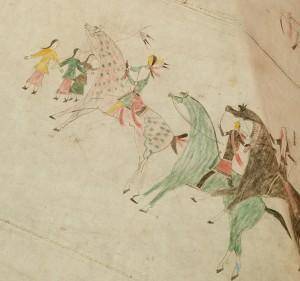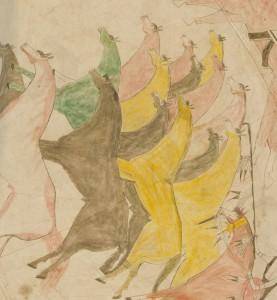In this lesson students will research topics related to the Lakota Tipi, migration, and the concepts of home and memories. They will then use empathy and their imaginations to complete writing and visual art activities.
Students will be able to:
- identify and use at least three sources of factual information;
- use words and visual images to represent essential themes of the data they collect;
- discuss hypothetical situations; and
- build, design, decorate, and discuss tipis of their own.
Lesson
Day 1
- Warm-up: Ask students to write down exactly what they did on the first day of school this year, making certain to include as many details as possible (give them about 3–5 minutes). After the exercise, ask them what was easy and what was difficult about remembering the information. Are such memories important? Why or why not?
- Share the picture of the Tipi with the students. Using information from the About the Art section, discuss the role of the Tipi, focusing on the use of the images to remember important events in history.
- Divide the students into groups, and have them conduct research about life and culture in the Lakota Nation (they will be sharing it at the end of class – to avoid repetition, you could assign groups different topics). Students should use at least three sources (provided by the teacher or found on their own – try to find/encourage them to find sources that are by Native authors or credible sources to avoid students researching stereotypes and misinformation). They should take notes using formats that are relevant to what you’ve been working on in class. (Note: To complete in one class period, you will need to have the resources ready for the students. These are some good books to start with: Memory and Vision: Arts, Cultures, and Lives of Plains Indian Peoples, The Plains Indians: Artists of Earth and Sky, or Tipi: Heritage of the Great Plains)
- If necessary, give students an extra day to do research and prepare presentations. Have students share what they have learned with the class in as formal or informal a format as you prefer.
Day 2
- Warm-up: Have students imagine that they are moving to Mars. In pairs, have them make up quick stories about their life on Mars, paying attention to details of what they see, feel, hear, taste, and touch.
- Show students the picture of the Tipi. Have them share in groups of 3–4 whatever information they remember from their research in the previous class period(s).
- Take time to lead a rich discussion of the following questions. You could have partners discuss their answers for each question, then discuss as an entire class:
- Do you tell stories in/on your own homes? How?
- What materials are used to tell important stories?
- What about families who have to move a great deal? Families who are homeless? Military families? Migrant farming families? How do they keep their stories with them and alive?
- Tell students they are going to do independent work to illustrate stories from their own lives, in their own art styles. Give them plenty of time to do this.
- Host gallery showings with half of the class touring the gallery and the other half talking about their drawings. Switch roles and repeat.
Materials
- Paper or journals for each student
- Assorted colored markers or pencils
- Student access to computers for research
- Some sources on the Lakota and Plains culture (such as Memory and Vision: Arts, Cultures, and Lives of Plains Indian Peoples, The Plains Indians: Artists of Earth and Sky, or Tipi: Heritage of the Great Plains), or student access to a computer and/or library for finding their own sources
- About the Art section on the Lakota Tipi
- One color copy of the Tipi for every four students, or the ability to project the image onto a wall or screen
Standards
- Visual Arts
- Invent and Discover to Create
- Observe and Learn to Comprehend
- Relate and Connect to Transfer
- Envision and Critique to Reflect
- Language Arts
- Oral Expression and Listening
- Research and Reasoning
- Writing and Composition
- Reading for All Purposes
- Collaboration
- Critical Thinking & Reasoning
- Information Literacy
- Invention
- Self-Direction
Tipi
- Attributed to
- Standing Bear, 1859-1934
This tipi was made by a Lakota artist. The Lakota people lived on the Great Plains, an area roughly between the Rocky Mountains and the Missouri River, from Texas up to southern Canada. Many, but not all, of the tribes who lived on the Great Plains used tipis as their primary form of residence. In most tribes, women were generally both the makers and the owners of the tipis, although men sometimes provided assistance in their construction. They were often made from the skins of buffalo that the men hunted. Women tanned the skins and then sewed them into a pattern to create a semi-circular one-piece covering. The name “Standing Bear” is written on the Denver Art Museum’s tipi, but we are not sure whether this is the name of the artist or possibly the identity of one of the figures depicted. It was not a Lakota custom for artists to sign tipis.
The tribes who lived on the Great Plains moved frequently as they hunted for food and required homes that could be erected quickly and transported easily. The earliest tipis were relatively small but increased in size after Europeans introduced horses to the area, which allowed tribes to carry larger and heavier loads. The materials used to construct tipis were dictated by what was readily available. The tipi covering, for example, was originally made from buffalo hide. The decimation of buffalo herds in the mid- to late-1800s, along with the availability of trade goods, caused a shift to tipis made of canvas. Later, with the building of western-style housing on reservations, tipis as a primary dwelling completely disappeared.
The construction of tipis varied slightly among the different tribes. Generally, three or four foundation poles are tied together near the top while they are lying on the ground. The tripod is then lifted upright and the poles are spread at the base. Additional poles are added to create an oval floor plan. The cover is then attached to the top of a pole and spread across the frame. The two edges of the cover overlap and are secured with wooden pegs. Smoke flaps are controlled by the use of two longer poles. During the hot summer weather, the sides could be rolled up to allow air to flow in and out of the tipi. Extra warmth was gained in the winters by banking snow outside the tipi. An inner layer was also added to the tipi and grass was used as insulation between the two layers. The Denver Art Museum tipi may have been used as a decorative outer cover for another smaller cover, since it lacks evidence of smoke at the top.
The images painted onto the tipi cover probably represent battle scenes. The establishment of reservations ended the nomadic and warrior lifestyle of the Lakota. Military exploits of earlier years became more significant for the Lakota and artists kept the stories alive through their drawings. Enemy tribes, such as the Crow and the Pawnee, are painted in great detail, allowing the viewer to recognize them by their distinctive clothing and hairstyles. Tipis like this one now serve as a historical record of the lives of those who created it.
Details

Canvas
This tipi is made of canvas, with wooden poles for support. Canvas was more readily available than the traditional buffalo hide (buffalo were becoming increasingly rare) and it made the tipi much lighter and easier to transport.

Narrative Painting
This style of painting, referred to as narrative painting, depicts a military scene. Military paintings were done exclusively by men, while women painted abstract patterns. By the late 1800s, Lakota drawings began taking on more realistic proportions. Paintings were not typically painted in chronological order. Images were arranged according to the artist’s preference, recording the essence of an event and not the specifics of time or place.

Horses
Red, green, and yellow horses circle the tipi. Artists often painted horses in a more decorative manner, in colors not normally attributed to the animal. In Lakota society, horses were an important symbol of power and wealth. Artists frequently depicted them as trophies secured in battle or as the prized possession of a rider.

Enemy Tribes
Warriors from the Pawnee and Crow tribes are recognized by their distinctive hairstyles and clothing. The Pawnee warrior is shown wearing high fashioned black moccasins.
Funding for object education resources provided by a grant from the Morgridge Family Foundation. Additional funding provided by the William Randolph Hearst Endowment for Education Programs, and Xcel Energy Foundation. We thank our colleagues at the University of Denver Morgridge College of Education.
The images on this page are intended for classroom use only and may not be reproduced for other reasons without the permission of the Denver Art Museum. This object may not currently be on display at the museum.







